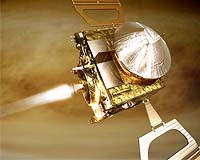

April 11, 2006 Darmstadt, Germany - The European Space Agency (ESA) reported this morning that "at the end of a 153-day and 400-million km cruise into the inner Solar System beginning with its launch on 9 November 2005, ESA’s Venus Express space probe fired its main engine at 09:17 CEST for a 50-minute burn, which brought it into orbit around Venus. With this firing, the probe reduced its relative velocity toward the planet from 29,000 to about 25,000 km/h and was captured by its gravity field. This orbit insertion maneuver was a complete success.
Click here to subscribe and get instant access to read this report.
Click here to check your existing subscription status.
Existing members, login below:
© 1998 - 2024 by Linda Moulton Howe.
All Rights Reserved.

